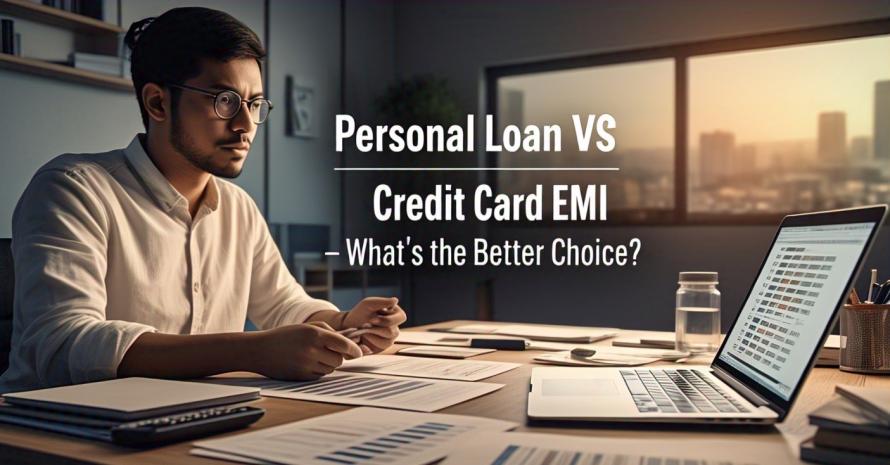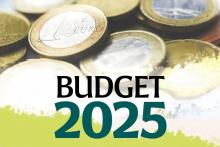Personal Loan vs Credit Card EMI – What’s the Better Choice?

Sometimes we need extra money—maybe for a big purchase, a wedding, or even an emergency. In these situations, people often choose between two options: a personal loan EMI or a credit card EMI. Both let you pay in monthly instalments, but they work differently. Let’s understand how.
What is a Personal Loan EMI?
A personal loan is money you borrow from a bank or a lender when you need it for personal use—like travelling, fixing your house, paying for education, or clearing other debts. Once approved, the bank sends the money directly to your bank account.
You agree to repay the loan in monthly payments (EMIs) over a fixed time, usually 1 to 5 years. The amount you borrow is fixed, and you pay interest on it every month. The interest rate depends on your credit score, income, and the bank’s policy. To get a personal loan, you need to show some documents like your ID proof, income proof, and sometimes bank statements.
Each bank offers different interest rates for personal loans. Here's a look at the rates offered by some of the top banks in India:
Personal Loan Interest Rates – Top Banks in India
| Bank Name | Interest Rate (per year) |
|---|---|
| State Bank of India (SBI) | 11.00% – 14.00% |
| ICICI Bank | 10.75% – 19.00% |
| HDFC Bank | 10.75% – 14.50% |
| Kotak Mahindra Bank | 10.99% onwards |
| Axis Bank | 10.49% – 21.00% |
| YES BANK | 11.05% – 20.25% |
What is a Credit Card EMI?
When you make a big purchase using your credit card, you can convert that amount into EMIs (Equated Monthly Installments). This means instead of paying the full amount at once, you can pay smaller amounts every month. Usually, purchases above ₹2,000 are eligible for this option. You can select a repayment period, also called tenure, which can be between 3 to 24 months. Some purchases even come with no-cost EMI offers, where you don’t have to pay any extra interest. There’s no paperwork involved, and the process is quick and easy.
Apart from purchases, you can also borrow funds directly from your credit card. After borrowing, you usually get a grace period of 15 to 25 days before the EMI payments begin. You will need to repay according to your credit card’s billing cycle. For such credit card loans, the tenure can go up to 24 or even 36 months. However, the bank will charge you interest, usually between 13% and 18% per year, depending on the bank and your profile.
Interest Rates for Credit Card EMI Loans by Bank
| Bank | Interest Rates (per annum) |
|---|---|
| HDFC Bank | As Applicable |
| SBI Card | 14% – 15% |
| Kotak Mahindra Bank | 12% – 18% |
| YES BANK | 13% – 15% |
| Bank of Baroda | 10% – 15% |
Key Differences at a Glance
| Feature | Personal Loan EMI | Credit Card EMI |
|---|---|---|
| Loan Amount | Higher (up to ₹25 lakh) | Limited to your card limit |
| Interest Rate | Usually lower (10–24%) | A bit higher (13–24%) |
| Tenure | 12 to 60 months | 3 to 24 months |
| Usage | Use for anything | Only for card purchases |
| Documents Needed | Yes | No |
| Approval Time | 1 to 3 days | Instant |
| Impact on Card | Doesn’t affect card | Uses your credit limit |
Credit Card or Personal Loan: Key Differences Explained
- Application Process: You can get a credit card from a bank or financial company. If you make a big purchase, you can convert it into EMIs easily, and you don’t need extra documents for that. But for a personal loan, you’ll need to submit some documents, and it usually takes 2–3 days to get approved.
- Repayment Time: Personal loans come with a fixed time to repay, usually up to 5 years. You can choose the time that suits you best. Credit cards work differently — you get a grace period of about a month to repay, and after that, interest is added. It works more like a monthly cycle.
- Interest Rates: The interest on credit card EMIs is usually between 13% and 18% per year. Personal loans have a wider range — between 10% and 25% per year, depending on the lender.
- Loan Amount: Personal loans usually let you borrow more money than credit cards because credit card loans depend on your card's credit limit.
When Should You Go for a Personal Loan?
- You need a larger amount of money.
- You want to pay back over a longer time.
- You need the money for something other than a purchase.
- You’re okay with filling out some paperwork.
When Should You Choose Credit Card EMI?
- You’ve already bought something with your card and want to split payments.
- You want a quick and easy EMI without documents.
- The amount is small to medium.
- You’re getting a no-cost EMI offer.
Which One is More Affordable?
In most cases, a personal loan is cheaper if you have a good credit score. But if you’re getting a no-cost EMI on your credit card, then that could actually be the best deal. Just make sure you check the terms and pay on time.
Final Thoughts
Both options have their own benefits. A personal loan gives you flexibility and a bigger amount, while a credit card EMI is great for quick conversions on purchases. Before choosing, think about how much money you need, how quickly you need it, and how long you want to take to pay it back.
Choose what fits your situation best—and always repay your EMIs on time to avoid extra charges and keep your credit score healthy.




Leave a Reply